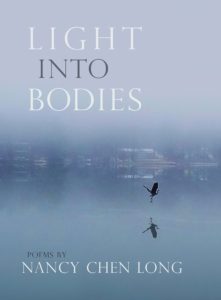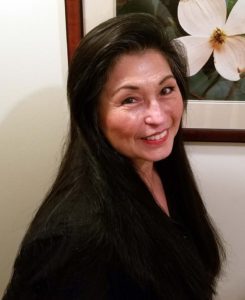
I came to Nancy Chen Long’s award-winning first book Light into Bodies (2016 Tampa Review Prize for Poetry) expecting the same deft use of scientific and mathematical imagery from this poet/electrical engineer/software consultant that I was familiar with from reading her work in literary journals over the past several years. Long’s professional background allows her to craft a careful mesh of the technical and the lyrical with an authority uncommon in the work of poets who borrow scientific concepts they don’t fully grasp. And Light into Bodies didn’t disappoint—in fact, Long’s preface poem, “On Seeing a Heronry of Egrets Nesting in a Tree,” contains lines embodying this filigree of vocabularies:
The set of egrets—the score of them, nested as they are
in the treed twilight—they could pass as a scatterplot,
snowy ellipses on a dark Euclidean plane. I want to discover
a pattern, a sine wave to impose, dogmatic
order to instill upon their random arrangement.
Contrary to my expectations, however, what most caught my attention on my initial read of Long’s collection was her interest in color. The book’s first section explores a childhood in which the child-speaker’s mother is marginalized by her immigrant status and her struggle to learn English. The speaker’s father is often absent, stationed abroad. Long renders the constraints, pressures, and griefs of this childhood in blue—a color that makes its way into many of the poems in the first section. There are bluebonnets, blue tinsel, a blue-plaid satchel, blue limestone, blue spruce and more. Blue, in the context of such a precarious childhood, made sense; blue being, as Rebecca Solnit writes in A Field Guide to Getting Lost, “that color of… remote mountain ranges, of anything far away… the color of there seen from here, the color of where you are not. And the color of where you can never go.” Blue is also the color of not being able to breathe.
Red, on the other hand, is the color of firecrackers, stoplights, and burning rashes. The second section of the book, which recounts a divorce and subsequent romantic involvements, contains the poem “Inflamed,” listing a myriad of hostile reds—glossed lips, ambulance lights, Mars, and scarlet fever—eventually coming to “our red flag of complicity” with this image: “lucky us, lucky red, lucky like me, / nubile bride in a crimson dress, gift-wrapped / in red, the bittersweet door to our house.”
It was Long’s switch from blue to red that made me both backtrack and glance forward through the collection looking for other instances of color. And I found them: greens and purples and yellows, along with Long’s own specifically crafted hues: “sulphur-colored,” “color of cracked earth,” “color of drizzle,” “sand-colored,” “constrained color,” “color of blitzkrieg.” Now aware of Long’s sensitivity to color, I went searching for its possible origin, and found it in her consideration of the color white, and what that color can mean to a biracial child. Consider these lines from “Before the Days of Self, or Elementary School Achievement Test as Primer,” from the book’s first section, with couplets that describe the familiar childhood ritual of taking standardized tests.
…press the sabered
lead, requisite #2,will fill in the hole,
will fill in the wholesquare so no white
is left.
This early mention of the color white presciently gestures toward the stanzas that follow, in which the schoolchild is segregated from her classmates with the teacher’s instructions that “‘All children are to color- / in ‘Caucasoid.’ Except three.” Later the child-speaker will address her white father to “apologize / for having failed / to achieve Caucasoid,” with that devastating repetition of a form of the root word “achieve.” As a white mother of biracial children myself, this book became for me an opportunity to glimpse, for a moment, the colors of the world, and of skin, as my children might.
Long’s consideration of color reaches its pinnacle in the contrapuntal poem “The Cleave of Color,” masterfully composed in two columns which can be read either across as full lines (reading through the column break) or vertically so that one column is finished before preceding to the next. Both readings are equally powerful, a rare achievement in this form. Consider these lines about a child coloring a picture of cart-wheeling girl:
–i didn’t want to color her. humans graft color with artifice and so
_i wanted her to be white. what is real seems real if some other says it is.
It’s difficult to say which of the two possible readings is more shattering, the columnar “humans graft color with artifice and so, / what is real seems real if some other says it is” or the linear “humans graft color with artifice and so / I wanted her to be white.” In addition, the realization that in this poem, as in nowhere else in the collection, “I” becomes lower case hits the reader hard with the duplication of powerlessness inherent in a speaker who is both a child and member of a minority. Thus the “other ” has more bearing on the speaker’s reality than the self does, leading to a sense of self-worth for which the descriptor “ambivalent” is far too mild. All this unspoken turmoil is compactly loaded by the poet into the lower case “i.”
Images of coloring in, whiting out, and erasing—all words to describe common grade school activities—recur in this collection. Compare the following two poems beginning with the long poem, “Continual Process Improvement for the Astute Young-Adult Student, or Lesson as Lesion,” which concludes with these lines:
to learn how
exactly how
one can improvethe lot of her skin
how she might better be
the blanched perfection
she’s been taughtshe must be blanched
in perfectionshe must be perfectly blanched
she must be whited out
Moving to the poem “Lessons,” an eraser, as opposed to other possible implements, is selected so that
___the woman my father hired
_____________________would push
the eraser-end of a yellow pencil
___into the mouth
of my mother__to teach my mother
how to make a proper
___________English sound.
The recurrence of the titular word “lesson” in these two poems emphasizes the overwhelming pile-up of instructions to deny identity, and yet Long’s persona triumphs. Noting, in the poem “‘Blazing Black Holes Spotted in Spiral Beauty,’” that “my father gave himself many names. // Dictionary Don, when we played Scrabble. / Later, he was Maldendo Vestibule,” Long’s persona follows in his footsteps to discover the power of choosing to name herself as an antidote to the labels of society. First, however, she has to overcome a man who calls her Luna, telling her “‘You / are the moon, good / only for reflected light,’” as well as her own conception of her Maker who “made me / marginalia in a book of names,” in order to arrive at the knowledge that “Our names, [are] as numbered as the stars,” a realization which finally frees her to name herself.
In the book’s last poem, tellingly titled “Occupying Fear,” the lines move from “In that previous era / I was named // Docile Teacup” to “Now I am called Tempest” to “In the next era, / I will name myself.” This assertive salvation was foreshadowed in the earlier poem “A Drift of Dust” with the lines “let our names be the urns that hold us, / skins we slip into—the garments that shield us // from the wind.” There are forces far colder than wind against which Long’s naming rituals are a shield.
I had high expectations for Long’s debut collection, and they were exceeded by the breadth of experience described: from childhood to divorce, from viewing art to stargazing, from the vagaries and strengths of relationships—familial and romantic—to pondering the intentions of God. Long delivers an entire life in this collection, but don’t assume her breadth suggest a lack of depth, as demonstrated in her deft representation of an individual’s understanding and internalization of race and color over a lifetime. This poet writes with uncommon insight and artistry, rendering the particulars of one person’s story recognizable, both painfully and triumphantly, to all readers.





